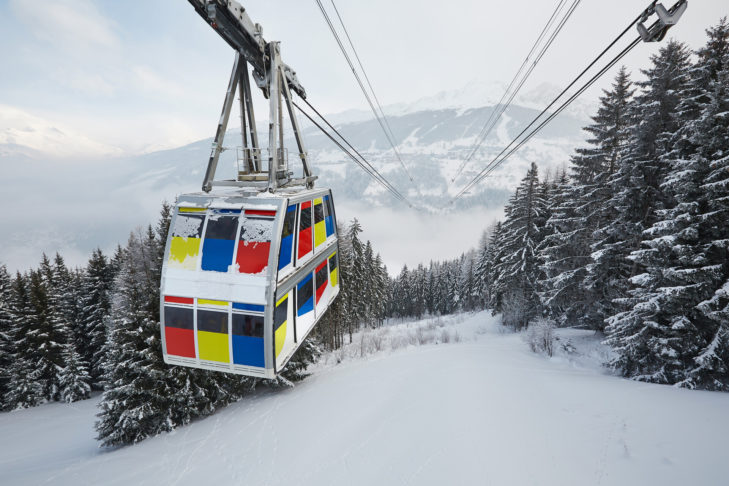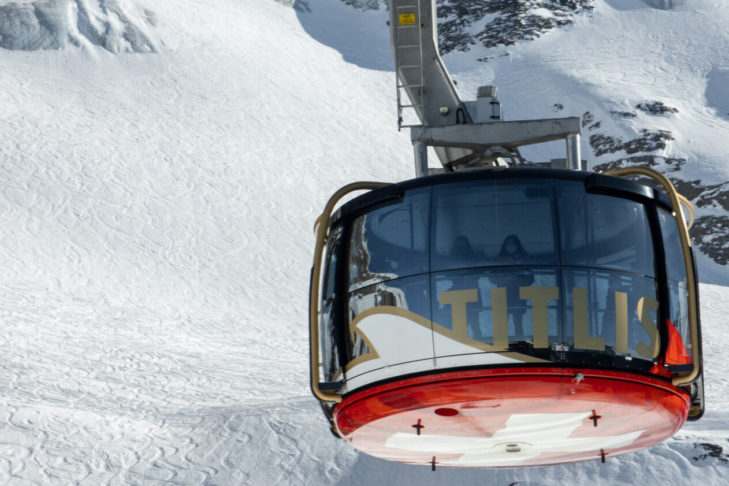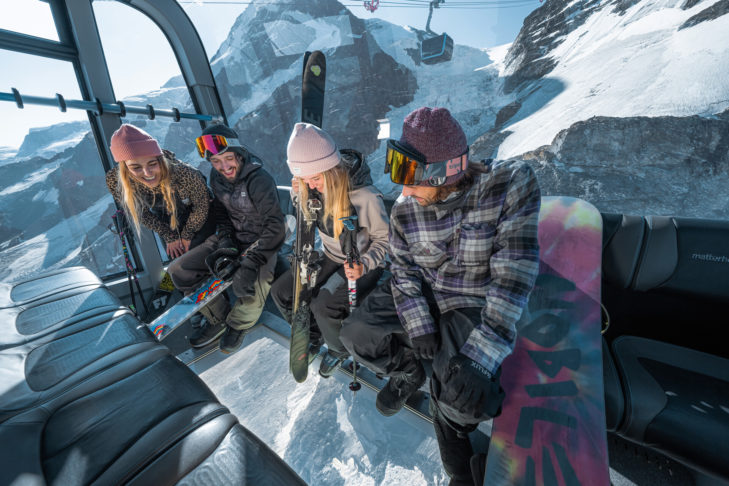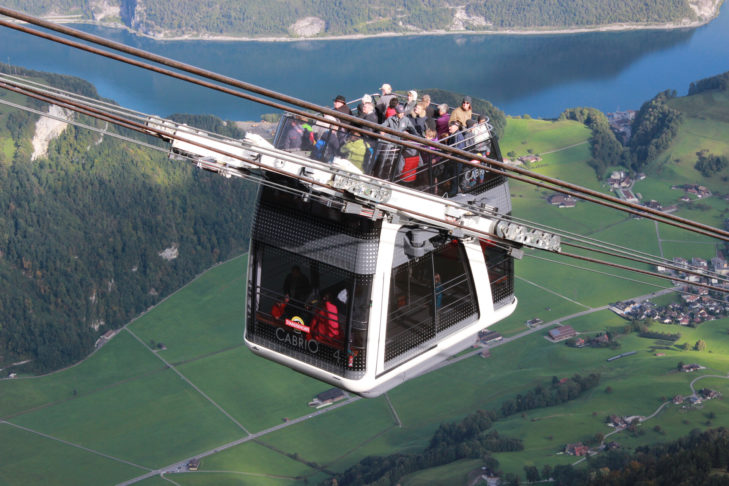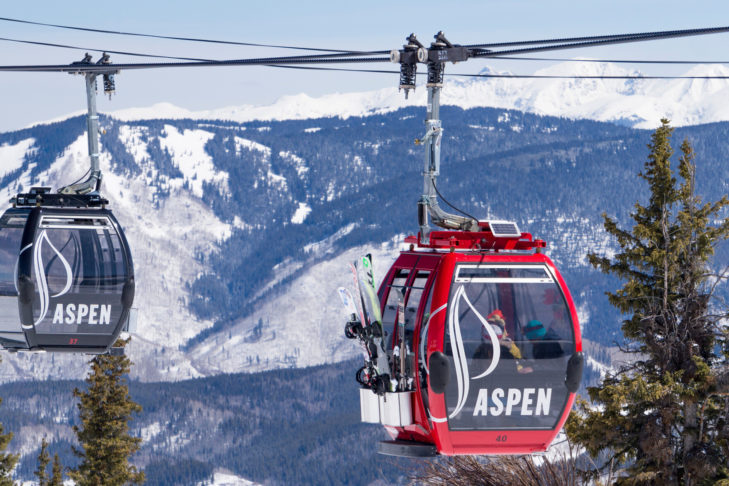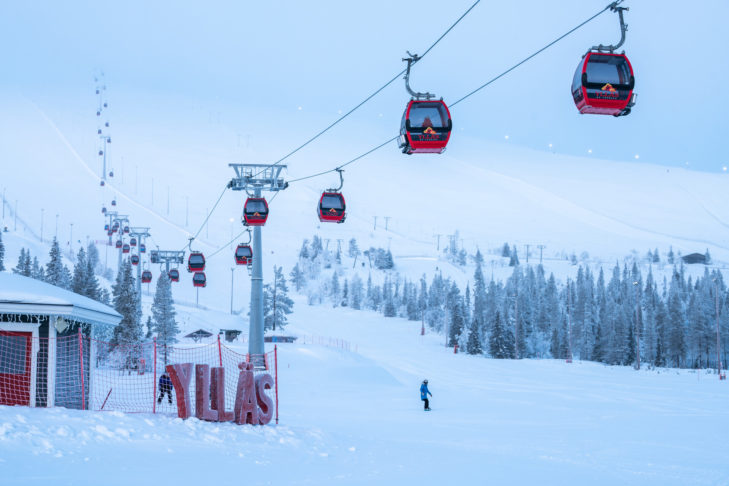Is simply getting to the top of the mountain really all that matters? That’s so yesterday. Today, ski resorts have more to offer. Every year, they outdo each other with the latest developments in terms of ski lifts. Some projects stand out in particular because they are no longer just about travelling up the mountain. Here, the journey becomes the destination. Or at least an absolute experience. And these are precisely the reasons for SnowTrex to present spectacular and extraordinary ski lifts and famous ropeways of superlatives.
World-famous cable cars at a glance
| Cable car | Austria | Ski resort |
|---|---|---|
| VIP gondola "The first flying limousine" | Austria | Ski area Hochzillertal-Hochfügen-Spieljoch |
| Wildspitzbahn | Austria | Ski area Pitztal Glacier & Rifflsee |
| Eisgratbahn | Austria | Ski area Stubai Gletscher |
| Tunnelbahn Fleißalm | Austria | Ski area Großglockner-Heiligenblut |
| Kitz 3S-Bahn | Austria | Ski area Kitzbühel-Kirchberg |
| Vanoise Express | France | Ski area La Plagne |
| Titlis Rotair | Switzerland | Ski area Engelberg-Titlis |
| Matterhorn Glacier Ride | Switzerland | Ski area Zermatt |
| Stuckli Rondo | Switzerland | Ski area Sattel Hochstuckli |
| Porsche chair lift „Lavadinas-Furcla“ | Switzerland | Ski area Flis-Laax-Falera |
| Solar ski lift Tenna | Switzerland | Ski area Tenna |
| Cabri0-Bahn | Switzerland | Stans |
| Zugspitzbahn | Germany | Ski area Garmisch-Classic, Zugspitze |
| Predigtstuhlbahn | Germany | Ski area Region Berchtesgaden |
| Silver Queen gondola | USA | Ski area Aspen Snowmass |
| Peak2Peak | Canada | Ski area Whistler Blackcomb |
| Sauna gondola | Finland | Ski area Ylläs |
| Wings of Tatev | Armenia | Halidsor |
| Dagu Glacier Gondola | China | Luhua |
| Dragondola | Japan | Nabea Skiresort |
| Genting Skyway | Malaysia | Gohtong Jaya |
| Mi Teleférico | Bolivia | La Paz and El Alto |
Historical background
When the first tourist cable cars were put into operation in Europe more than 100 years ago, the idea itself was simple, but the construction was all the more complex. However, thanks to advanced technology, it was possible to reach mountain heights in a very short time that would otherwise have been difficult to climb. The Kohlererbahn in Bolzano in South Tyrol is one of these early examples. It is considered to be the first pure passenger cable car in the Alps.
With the emergence of ski tourism and its rapid spread from the 1950s onwards, a new guiding principle in cable car construction became established. It was no longer just about making the mountains accessible to holidaymakers, but about how many people could be transported in the shortest possible time. After all, nobody wanted to queue. Today, in the 21st century, this applies more than ever, as millions of winter sports enthusiasts flock to the world’s ski resorts every year. Cable cars have long since become high-performance means of transport. In the Austrian Zillertal Arena alone, 80,000 ski holidaymakers can be transported – in one hour! And at speeds of sometimes 10 metres per second (m/s) and more. In contrast, the maximum values achieved a century ago look rather modest: 24 people per hour and a travelling speed of 1.6 m/s were achieved by the Kohlererbahn, for example.
Today, cable car companies can hardly distinguish themselves by speed or higher transport capacities. Some transport their guests swiftly, others quickly. However, to ensure that not only the experience on the piste afterwards, but also the journey itself is a special experience, some operators have come up with a few ideas for their cable cars and lifts.
“The first flying limousine” in the Hochzillertal-Hochfügen-Spieljoch ski area (Austria)
The Hochzillertal-Hochfügen-Spieljoch ski area attracts luxury-loving guests with a particularly exclusive offer. The creators call the VIP gondola, which takes winter sports enthusiasts up to an altitude of 2,500 metres, the “first flying limousine”. It was developed by Leitner ropeways in collaboration with BMW Individual. The cable car manufacturer supplied the modern Sigma Diamond cabin. The Bavarian car manufacturer, on the other hand, supplied the interior, which is impressive: fine brown leather seats including massage function and seat heating, a centre console with climate control unit and the multimedia system familiar from the BMW 7 Series limousine.
In the front console, gondola passengers will also find a bottle of champagne and two glasses. A sound system provides background music. Of course, this pleasure does not come for free. Various packages can be booked. For example, there is the “Early Bird” package for all those who want to get up the mountain as early as 8 am. Two people park in a reserved car park, are welcomed with champagne, take the VIP gondola up the mountain and then enjoy breakfast in a mountain hut. The ski passes are included.
Wildspitzbahn cable car in the Pitztal Glacier & Rifflsee ski area (Austria)
If you’ve always wanted to sip a Fiaker or Einspänner with a view of three-thousand metre peaks such as the 3,774 m high Wildspitze, then Austria’s highest café is the place for you. The Wildspitze cable car mountain station and Café 3.440, named after its altitude of 3,440 metres, are perched high up on the Pitztal Glacier and form the highest cable car station in the Alpine republic. “Tyrol’s new high point” offers 160 seats in the café and on the terrace and serves exquisite coffee specialities and cakes. The Doppelmayr gondolas with heated seats take eight people at a time up to the unique vantage point in 5.6 minutes.
Eisgratbahn in the Stubai Glacier ski area (Austria)
The spectacular Eisgratbahn cable car is located in the Stubai Glacier ski area. With an inclined length of 4,686 metres, the ultra-modern lift is the longest 3S lift in the Alps. The glass, futuristic-looking valley station is located at just under 1,700 metres, while the “Eisgrat” mountain station is around 2,900 metres above sea level. The spectacular construction project began in June 2015 and just 16 months later, on 22 October 2016, the Eisgratbahn made its maiden voyage. Since then, 48 modern cabins, each with 32 seats, have been transporting up to 3,000 winter sports enthusiasts per hour. At a speed of around 25 km/h, the journey only takes around 12 minutes and time literally flies by on this cable car. The cabins boast a chic design by Pininfarina, as well as genuine leather seats, panoramic glazing and free Wi-Fi.
Fleißalm tunnel lift in the Großglockner-Heiligenblut ski area (Austria)
In the Heiligenblut ski area, winter sports enthusiasts cannot enjoy a mountain panorama on the ascent with the tunnel railway. Instead, it goes from the Roßbach middle station through an old water tunnel to the Fleißalm and back again. In around 7 minutes, winter sports enthusiasts overcome a difference in altitude of 63 metres. It’s not really steep, but it offers impressions that you can’t get from any other lift.
Kitz 3S cable car in the Kitzbühel-Kirchberg ski area (Austria)
At 400 metres above ground, the 3S lift in the Kitzbühel-Kirchberg ski area is the highest in Europe. Only the “Peak2Peak” lift in Whistler, Canada, also a tricable gondola lift, is even higher at 436 metres. The 3S lift connects the Hahnenkamm/Pengelstein and Jochberg/Resterhöhe ski areas and is considered the main artery of the Kitzbühel ski area. To experience the immense height even more intensively, one of the gondolas is equipped with a glass floor. A head for heights is therefore advisable here!
Vanoise Express in the La Plagne ski area (France)
The Vanoise Express in the French Alps is the largest double-decker cable car in the world. It can carry an incredible 200 people on two levels, including skis, poles and luggage, and even when fully loaded, it only takes four minutes to cover the 1,824 metre route. The route is also unusual: there is no valley and mountain station. This means that the start and finish are almost at the same altitude. It is also impressive that the rope does not need any support pillars along its entire length from La Plagne to Les Arcs. With these gigantic figures, the Vanoise Express overtook the “Twinliner” in Ischgl-Samnaun after its commissioning. Until then, the gondola lift in the Silvretta Arena was the largest double-decker lift with 180 seats per cabin.
Titlis Rotair in the Engelberg-Titlis ski area (Switzerland)
The Engelberg-Titlis ski area also has a very special cable car ride in store for winter sports enthusiasts. The Titlis Rotair is the world’s first revolving aerial cableway. It transports skiers and snowboarders from the Stand middle station to the summit station at an altitude of 3,020 metres. And as the name of the gondola suggests, it goes round and round! After all, it turns through exactly 360 degrees on every journey. During the five-minute ascent, snow lovers can enjoy a fabulous panoramic view of snow-covered peaks, deep crevasses and rugged rock faces. Incidentally, the old Titlis cable car was built in its original form between 1988 and 1992, before the Rotair gondolas began whizzing towards the summit in the 2014 winter sports season.
Matterhorn Glacier Ride in the Zermatt ski area (Switzerland)
The highest cable car station in Europe is located on the Klein Matterhorn in Zermatt, Switzerland: the mountain station of the tricable gondola called “Matterhorn Glacier Ride I”. The mountain station is located in the Matterhorn glacier paradise ski region at an altitude of no less than 3,883 metres. The complex construction of the world’s highest tricable gondola lift was completed in autumn 2018. Up to 2,000 people are transported to the mountain station on the Klein Matterhorn every hour. And 365 days a year! The gigantic construction project cost around 60 million Swiss francs. The cable car manufacturer Leitner Ropeways and the Pininfarina design studio, which is known from Ferrari and Maserati, were among those involved in the construction. From the mountain station, winter sports enthusiasts have a fantastic view of 14 glaciers and an impressive 38 other Alpine giants.
The Matterhorn Glacier Ride II completes the “Matterhorn Alpine Crossing”
But the spectacular cable car in the shadow of one of the world’s most famous mountains was just the beginning of a no less impressive project: the Matterhorn Alpine Crossing. As the name suggests, the new gondola route was intended to cross the Alps – and not only that. With the opening of the “Matterhorn Glacier Ride II” in July 2023, holidaymakers will also be able to cross the border between Switzerland and Italy. The superlative cable car connects the mountain station on the Klein Matterhorn with the Testa Grigia valley station (3,458 m) above Cervinia in the neighbouring country, making it the highest border crossing in the Alps. Like the first part of the mega project, the second section of the line cost 60 million Swiss francs. The two gondolas can transport up to 1,300 people per hour. And they have to pay up to 240 Swiss francs per person for a return journey, the equivalent of an impressive 246 euros (as of 6 July 2023)!
Stuckli Rondo in the Sattel Hochstuckli ski area (Switzerland)
In the Swiss saddle, it doesn’t matter where you sit in the eight-seater gondola lift. This is because the Stuckli Rondo rotates twice around its own axis during the eight-minute journey, regardless of speed. This means that every winter holidaymaker can enjoy an all-round panorama.
Porsche chairlift “Lavadinas-Furcla” in the Flims Laax Falera ski area (Switzerland)
A world first went into operation in Laax in winter 2012/2013. The Plaun Lavadinas – Fuorcla da Sagogn 6-seater chairlift has a sleek Porsche look. And it’s no wonder, as the lift was developed by Bartholet Maschinenbau AG in collaboration with the design studios of the car manufacturer from Zuffenhausen in Swabia. The unique design – black armchairs with red applications – is immediately reminiscent of the interior of a super sports car. But that is not the only special feature. Thanks to a joint on the cable suspension, the seats can be swivelled by 45 degrees. This gives passengers a clear view of the mountain panorama instead of having to look at the back of the person in front of them. The approximately 600 metres in altitude are covered at a speed of 6 m/s on the journey to the mountain station. A solar panel on the back of the seats also covers the power requirements of the integrated seat heating.
In addition to the design of the stylish chairlift, the Weiße Arena Gruppe’s concept also included the valley and mountain stations of the new lift. Sustainability and the use of environmentally friendly materials were also important to the operators here. Both stations were built partly from alternative, environmentally friendly materials. Even from a distance, the mountain station stands out due to its high proportion of wood.
Tenna solar ski lift in the Tenna ski area (Switzerland)
Environmental protection has also long been an issue in many ski resorts. Many winter sports resorts are looking for ways to actively protect and preserve the nature and landscape in and from which they live. The idea for a special kind of anchor lift in Tenna, which is actually powered exclusively by solar energy, came about after the old lift at the same location had become obsolete after 41 years in operation. Two things were therefore immediately clear: a replacement was needed and the conditions for financing a new system through the Tenna Ski Lift Co-operative were also met. Because the project had to be environmentally friendly and conserve resources, the decision was ultimately made in favour of a globally unique approach.
The result is a state-of-the-art solar installation with panels mounted on a cable construction above the conventional anchor lift. The system not only supplies the anchor lift with electricity, but also produces a surplus. Thanks to state-of-the-art technology, the photovoltaic cells are always aligned with the position of the sun – at a perfect south-facing angle of 30 degrees. This allows the system to produce up to 90,000 kWh per year. However, only around 22,000 kWh are needed to operate the lift. This means that the Tenna Ski Lift Cooperative can sell the additional electricity produced to the local electricity company – and thus gradually refinance the lift.
CabriO cable car in Stans (Switzerland)
A cable car only for those with a head for heights: Although the CabriO cable car on the Stanserhorn in Switzerland only operates during the summer season (April to November), it still deserves a mention here. The double-decker aerial tramway is the first in the world to have an open upper deck, allowing you to admire the fantastic 360° panorama of the surrounding mountains. It offers space for up to 30 people, who can enjoy the ride from the middle station up to 1,900 metres above sea level in the open air.
Zugspitzbahn in the Garmisch-Classic/Zugspitze ski area (Germany)
With 60 kilometres of pistes and 29 lifts, the Garmisch-Classic/Zugspitze ski area has a lot to offer. One of the highlights of the ski area is undoubtedly the Zugspitze cable car, which sets three world records on its ten-minute journey: It holds the world’s highest steel support (127 m) for reversible aerial tramways and, at 1,945 m, covers the greatest total difference in altitude in one section. In this section, the lift’s two gondolas also travel over the world’s longest free span at 3,213 metres. In the cabins themselves, winter sports enthusiasts are surrounded by floor-to-ceiling panoramic windows, giving them a breathtaking view of the German Alps. Once at the mountain station (2,720 m), the popular, rather flat slopes of the Zugspitzplatt open up as well as a true deep-snow Eldorado for adventure-seekers.
Predigtstuhlbahn in the Berchtesgaden ski region (Germany)
Winter sports enthusiasts can experience a special kind of time travel in the Region Berchtesgaden ski resort. In this case, the time machine is the Predigtstuhlbahn, which takes you up the eponymous Predigtstuhl mountain (1,614 metres). The first ride took place on 1 July 1928, so the lift is almost 100 years old and still in operation. However, skiers and snowboarders should not be impatient, as the lift is obviously no longer the youngest and certainly not the fastest. In any case, the gondola ride in Bad Reichenhall is a wonderful experience.
Silver Queen gondola in the Aspen Mountain ski resort (USA)
Skiers and snowboarders travelling up Aspen Mountain in the Silver Queen gondola should definitely choose one of the red cabins. Because here the winter sports enthusiasts themselves determine the music: as the gondolas are equipped with a docking station for the smartphone, the ride up the mountain also becomes a musical experience. And without having to put on headphones or plug them into your ears. So if you’re in the right mood, you can have a little party in the lift.
Peak2Peak in the Whistler-Blackcomb ski resort (Canada)
The Peak2Peak cable car is located in Canada and connects the two ski resorts of Whistler Mountain and Blackcomb Peak. Only a few support pillars are required to ensure a smooth ascent. The steel cables are suspended in the air over a total length of 3 kilometres above the valley, making the installation one of the longest self-supporting cable cars in the world. The Peak2Peak cable car is also the highest of its kind, as it hovers a dizzying 436 metres above the ground at one point.
Sauna gondola in the Ylläs ski resort (Finland)
The Finns are known for their love of the sauna. And it is precisely this passion that the lift operators at Yllästunturi in the Kolari ski region have taken to the extreme. Or rather: to the summit. The Ylläs ski resort is located near the Swedish border in the province of Lapland, and its highest point is the 718 metre-high mountain of the same name. And to reach it, winter sports enthusiasts use the lifts provided for this purpose – as is only right. What is unique, however, is that one of the cabins catches the eye from afar with its wooden panelling and, on closer inspection, turns out to be a very special kind of sweat cabin: the world’s first sauna gondola!
Up to four people can sit in the sauna cabin and work up a sweat for 15 to 20 minutes in icy outside temperatures, because that’s how long a ride lasts. At the mountain station, the gondola is electrically heated to the optimum temperature. Then the two-kilometre ride begins. The warm ski clothing has to stay outside, however, as you will be sweating naked, as it should be. Nobody has to worry about being watched by other skiers, as the cabin is equipped with darkened windows. Once at the top, the “Café Gondel” with showers, whirlpool and other saunas awaits sauna-goers.
But hardly anyone will come to Ylläs just for the sauna. The ski resort has much more to offer its guests. It doesn’t impress with its sheer size like the mega ski resorts in France or Austria. Nevertheless, it is well worth combining skiing and wellness here. Ski aces can show off their coolness before or after a sweat-inducing sauna session on 55 kilometres of pistes. Countless kilometres of cross-country trails are of course also a must in the cross-country skiing nation of Finland. And to round off a successful day of skiing, winter sports enthusiasts should not miss out on the magical Northern Lights in the sky!
Wings of Tatev in Halidsor (Armenia)
The “Wings of Tatev” cable car may not transport skiers, but it does set a real cable car record. The world’s longest aerial tramway, the Tatev, was opened in the south of Armenia in 2010. With a length of 5.75 kilometres, the cable car transports up to 25 people on an eleven-minute journey from the village of Halidsor via the Vorotan Gorge up to the historic Tatev Monastery. However, it only covers a height difference of 9 metres.
Dagu Glacier Gondola nearby Luhua (China)
The world’s highest cable car is located in the Chinese province of Sichuan in the Dagu Glacier National Park. The monocable gondola lift leads to a dizzying 4,843 metres. At this altitude, the air is so thin that you can literally get dizzy, which is why both the stations and the gondolas are equipped with oxygen bottles and masks. A total of 36 detachable cabins for eight people each take 9.4 minutes for one journey.
Dragondola in Nabea ski resort (Japan)
The Nabea-Tashiro Gondola monocable gondola lift at the Nabea Ski Resort in Japan, also known as the “Dragondola”, is an 8-seater monocable gondola lift with a length of 5.48 km. A journey in the cabins, which are designed for eight people, takes 15 minutes. The cable car connects the villages of Nabea and Karuga, providing access to the Kagura, Tashiro and Mitsumata ski resorts.
Genting Skyway in Gohtong Jaya (Malaysia)
At 21.6 km/h, the “Genting Skyway” is the world’s fastest cable car. With a length of over 3.5 kilometres, it is also the longest in South East Asia. The cable car runs through dense jungle and serves as a feeder to the Genting Highlands. At the top of the mountain is a resort with numerous hotels and an amusement park. It is the only place in Malaysia where gambling is officially permitted.
Mi Teleférico between La Paz and El Alto (Bolivia)
The “Mi Teleférico” cable car network offers fast and reliable transport between the most important sights of La Paz and El Alto in Bolivia. With 25 stations and a length of around 27 kilometres, it is the largest in the world. With the commissioning of the cable cars in the South American country, the journey time through the city has been reduced from one hour to just 10 minutes. The cable car network thus fulfils its original purpose: to reduce traffic problems and the associated environmental impact.
Well then: have a good trip!
These were the longest, fastest and most spectacular cable cars in the world.
FAQ on cable cars of superlatives
When were the first cable cars built in the Alps?
The first cable cars for tourist purposes were built in Europe over 100 years ago. The Kohlererbahn in Bolzano in South Tyrol is considered to be the first alpine cable car for passenger transport only. This aerial tramway was put into operation as early as 1908. With the development of ski tourism in the Alps, cable cars became increasingly important from the 1950s onwards.
Which is the highest cable car in Europe?
The highest cable car in Europe is the “Matterhorn Glacier Ride” tricable gondola lift on the Klein Matterhorn in the Swiss ski resort of Zermatt. The top station of the 3S cableway is located at 3,883 metres above sea level. The ultra-modern cable car transports up to 2,000 people per hour, 365 days a year.
Which is the longest cable car in the world?
With a length of 5.75 km, the “Wings of Tatev” is the longest aerial tramway in the world. It is located in the south of Armenia, was opened in 2010 and transports up to 25 people per journey from the village of Halidsor via the Vorotan Gorge up to the historic Tatev Monastery. A ride on the world’s longest cable car takes around 11 minutes, during which only 9 metres in altitude are covered.
What records does the Zugspitzbahn in the Garmisch-Classic/Zugspitze ski area hold?
The Zugspitze cable car in the German ski resort of Garmisch-Classic/Zugspitze holds three world records. During the ten-minute ride on the aerial tramway, holidaymakers are carried by the world’s highest steel support (127 m) for aerial tramways and overcome the greatest total difference in altitude (1,945 m) in one section. In addition, the gondolas of the lift in this section overcome the longest free span in the world (3,213 m).
Where can passengers cross a national border by gondola?
The “Matterhorn Glacier Express II” was opened in 2023. The special thing about this cable car is that the mountain station is located above Zermatt on the Klein Matterhorn (3,883 m) and therefore in Switzerland, while the valley station is on Testa Grigia (3,458 m) in Italy. However, the spectacular cable car is not the only one of its kind to cross a national border in the Alps. The Vallée Blanche small gondola lift has been operating between the Aiguille du Midi (3,778 m) and the Pointe Helbronner (3,466 m) since 1957. What makes it special: The mountain station is on the French side, the valley station on the Italian side.



